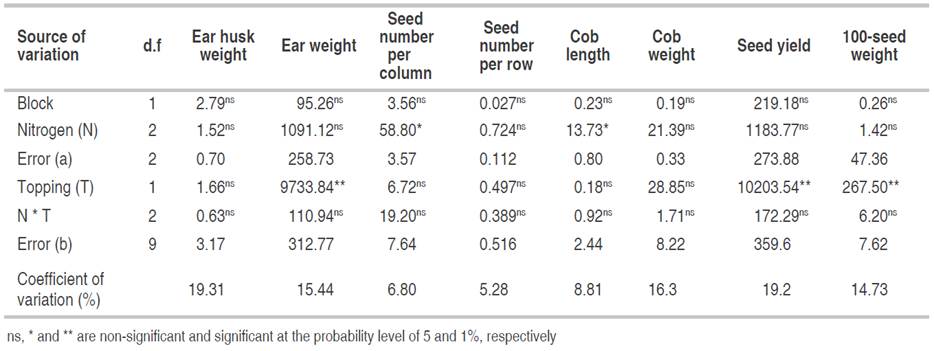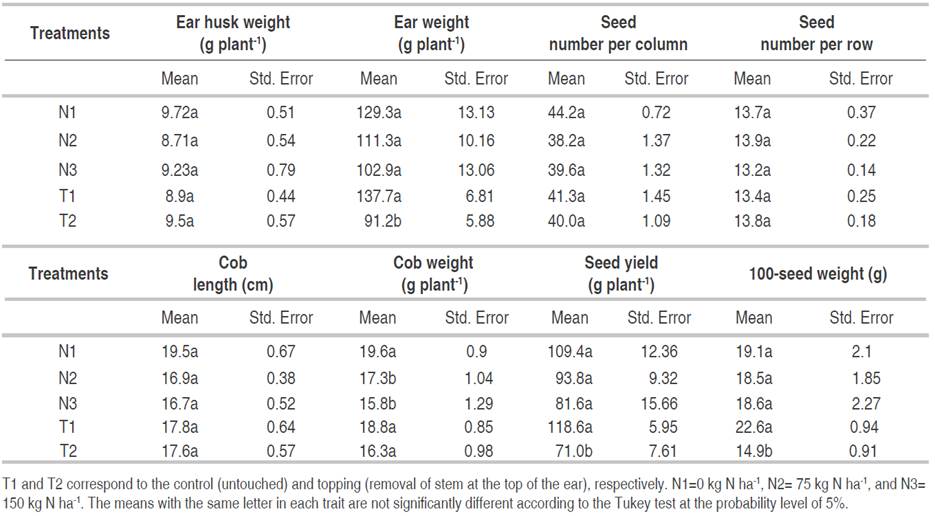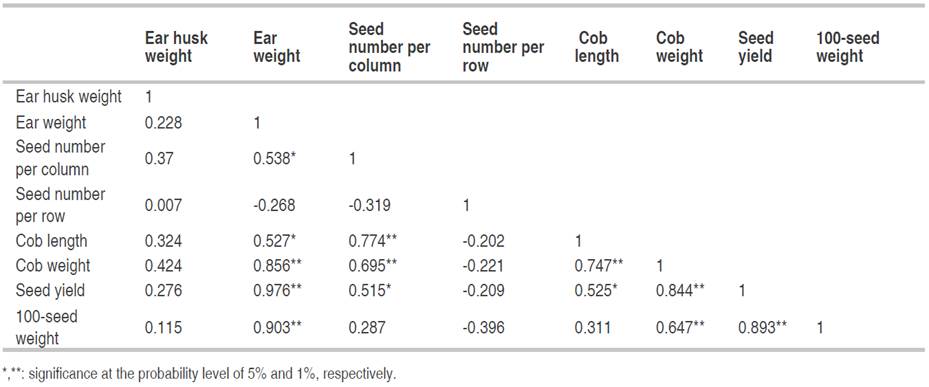Maize is a plant cultivated as fodder or seed. The seeds of this plant are used for poultry and fresh fodder or silage is required for animal husbandry. Maize residues after seed production become woody and hardly rot in the soil. These residues are a barrier to tillage operations. One way to use maize as a dual-purpose crop is to use the seeds and leaves of the plant (Homann et al., 2013).
Defoliation has been studied in many experiments by several authors (Martínez et al., 2014; Balducci et al., 2020; Toïgo et al., 2020; Wang et al., 2020; Scasta et al., 2021). Maize leaf removal improved photosynthesis, morphological characteristics, and seed yield in soybean under maize-soybean relay-intercropping (Raza et al., 2019). Weekly defoliation at low and high nitrogen levels showed that at low nitrogen levels, dry matter accumulation in shoots and roots of Festuca rubra decreased (Paterson and Sim, 2000). Nitrogen is an essential nutrient for plants (Albdaiwi et al., 2019); the availability of nitrogen improved plant growth from defoliation damage in wheat (Heidari and Nosratti, 2016). Nitrogen application of 75 kg ha-1 with no leaf removal (control) had the highest seed yield in chickpeas (Cicer arietinum L.). Nitrogen application of 75 kg ha-1 with complete removal of leaves had the lowest seed yield (Amini et al., 2017). Defoliation affects the growth and photosynthetic capacity of plants, remobilizes carbon and nitrogen reserves, and improves source-sink relationships (Iqbal et al., 2012). Defoliation at the eight-leaf stage, regardless of nitrogen content, did not reduce seed yield compared to no defoliation. Nitrogen fertilizer application as a top dressing at the fifteen-leaf stage increased seed yield due to a reduction in degradation caused by defoliation. Defoliation at the tasselling stage caused a great reduction in seed yield (Sangoi et al., 2014). The effect of leaf removal and nitrogen on maize showed that compared to untouched treatment, seed yield reduction under removal of upper and lower leaves was 22.2% and 4.2%, respectively. As the amount of nitrogen increased, the redistribution of stem assimilates increased and to some extent, the effect of removal of the lower leaves of maize on seed yield was compensated (Modhej et al., 2014).
Optimal removal of maize leaves improved photosynthesis and sink-source ratio after silking, resulting in maximum grain yield. So, less dense cultivars should have fewer or smaller upper leaves to reduce leaf area and therefore increase the light distribution. However, for denser cultivars, the leaves below the ear should age rapidly to reduce leaf respiration (Liu et al., 2020).
Among the different treatment compositions of topping and nitrogen levels, the highest plant, diameter, leaf number, leaf area, and seed yield of maize were observed under treatment composition of no topping and 150 kg N ha-1 (Shesh et al., 2019). Topping at two weeks after anthesis had no adverse effect on seed yield. Therefore, a significant amount of fodder can be harvested without reducing grain yield. Although topping increased the 1000-seed weight compared to the control, no significant difference was observed in their grain yield (Tahmasbi et al., 2001). The results of research on the response to topping and nitrogen levels showed that grain yield, cob length, and grain number per row were highest in no topping treatments. Harvest index and cob diameter increased under topping conditions. Similarly, all of these traits were superior under 150 kg N ha-1. The lowest value was obtained in treatments without fertilizer application (Shesh et al., 2020).
The environment of the mother plant can affect the germination of the produced seeds (Laossi et al., 2010; Cendán et al., 2013; Edwards et al., 2016; Dewan et al., 2018; Geshnizjani et al., 2019). Application of 100 kg N ha-1 in rapeseed fields produced seeds that had a higher germination percentage and shorter germination time than the control (Oskouie, 2012).
According to the literature review, most studies use the leaves of the maize plant to produce fodder; there are few studies on the effect of topping (removal of the upper stem of the ear) and nitrogen fertilization in maize to produce fodder. Therefore, this study aimed was to determine the best treatment combination of topping and nitrogen for dual-purpose production of maize grain and fresh fodder. Another objective of this project was to determine the germination traits of maize seeds produced from material plants under topping and nitrogen conditions.
Field experiment
The field experiment was conducted as a split-plot design based on a complete randomized block design with three replications. The studied factors were nitrogen fertilizer as a main-plot and topping factor as a subplot. Nitrogen fertilizer factor included application rates of 0, 75, and 150 kg ha-1. Topping factor included topping (stem removal at the top of the ear) and no topping. This research was conducted in the arable lands of Chamchamal plain located in Kermanshah. The soil of this region is one of the most fertile soils in the west of Iran and has a wide groundwater aquifer. Most farmers in the area use wheat-maize rotation. In recent years, the area under maize cultivation in this region has grown beyond the area under wheat cultivation. At the beginning of March 2014, the soil of the field was plowed using a moldboard plow. Then, triple superphosphate fertilizer at the rate of 333 kg ha-1 was applied under the soil using a cultivator. Single cross 704 maize seeds were sown at a rate of 27 kg ha-1 using a pneumatic maize seeder with a row spacing of 75 cm. The sowing date was April 7, 2014. Urea fertilizer at the rate of 367 kg ha-1 was applied as a top dressing to all treatments at two stages on May 31 and June 22. Soil texture, pH, electrical conductivity, and nitrogen were silty clay loam, 7.2, 1.6 ds m-1, and 0.2 %, respectively.
The most important weeds in the field were red-root amaranth (Amaranthus retroflexus, johnsongrass (Sorghum halepense (L.) Pers.), common lambsquarters (Chenopodium album), green foxtail (Setaria viridis), Chinese lantern (Physalis alkekengi), black nightshade (Solanum nigrum). Nicosulfuron and 2,4-D plus MCPA herbicides were used to control weeds.
During the growing season, the plants were irrigated eight times. Plants were sowed on the ridge and the method of irrigation was furrow. The time of application of experimental treatments was July 30 at the beginning of the seed filling period, seed milking stage. Then, topping and nitrogen were applied 114 days after sowing. The criterion for phenological stages, such as the seed filling stage, was the entry of at least 50% of plants into that stage. In the topping treatment, the maize stalk was cut just above the ear using a cutter.
At harvest time, three plants were selected from the two midlines of each plot. After drying the ears, the ear husks were weighed first. Then, the weight of the ear without husk was obtained. The seed number per ear row, the seed number per column of ear, cob length, cob weight, seed yield, and weight of 100 seeds were also calculated.
Laboratory experiment
A laboratory experiment was conducted to evaluate the effect of the mother plant environment on seed germination at the Crop Physiology Laboratory, Faculty of Agricultural Science and Engineering, Razi University in 2014. In the laboratory experiment, the germination traits of seeds produced from the maternal plant under topping and nitrogen were investigated. The laboratory experiment was conducted as a factorial experiment based on a completely randomized design with three replications. Seeds related to each field treatment were surface disinfected separately using sodium hypochlorite. Then, 10 seeds were placed on filter paper in a Petri dish. The Petri dishes were stored in a germinator at 25 °C for one week. After one week, germination traits such as germination percentage, radicle and caulicle length, and seed vigor were measured. Seed vigor was obtained by the following equation (Heidari, 2013).
Data analysis
Data were analyzed by analysis of variance and mean data were compared using the Tukey test at the 5% probability level. Before analyzing the data, the normality test was performed. Correlation between traits was also calculated. Statistical calculations were performed using SAS, SPSS, and MINITAB software (Soltani, 2013).
RESULTS AND DISCUSSION
Field experiment
Ear husk weight and ear weight. Analysis of variance and mean comparison showed that topping and nitrogen did not affect the ear husk weight (Tables 1 and 2). This is probably because the ear cover, like the organ that covers the ear, begins to grow before other parts of the ear. This organ has probably reached its final growth at the milking stage of the seeds. The ear husk as a photosynthetic organ plays an important role in grain filling (Koocheki and Sarmadnia, 2011). Analysis of variance showed that nitrogen had no effect on ear weight, but topping had a significant effect on ear weight (Table 1). Mean comparison showed that there was no difference between nitrogen levels in terms of ear weight but topping reduced ear weight (Table 2). These data showed that topping reduced the ear weight and nitrogen application could not reduce the damage caused by topping. The plant may have already taken the nitrogen necessary for the growth of its reproductive organs from the soil during the milking stage of the seeds, or the amount of soil nitrogen may have been sufficient before applying the nitrogen treatments. The results of soil testing showed that the amount of soil nitrogen for maize is appropriate based on the research of others (Sarafraz-hezarmasjed, 2022). In a study, nitrogen application at the stage of spike emergence reduced defoliation damage in wheat (Heidari et al., 2013). Part of the difference between the present experimental results and the results of others is related to the stage of application of the treatments. In the present study, the time of nitrogen application was the milking stage of the seeds.
Seed number per column and row of the ear. Mean comparison showed that there was no difference between the nitrogen rate and the topping in terms of seed number per column and row of the ear. No significant difference between the treatments is probably because the seed number per ear of maize is determined during pollination and only the seed weight may change after pollination (Koocheki and Sarmadnia, 2011). The results of this study also confirmed that the seed weights changed. In a study on maize, it was reported that the removal of the top two leaves had no effect on the number of seeds per plant because the removal caused nitrogen remobilization from the vegetative organs to the seed and increased photosynthetic capacity to absorb nitrogen, but removing more leaves reduced the number of seeds per plant (Liu et al., 2017).
Length and weight of cob. Mean comparison showed that there was no difference between the nitrogen rate and the topping in terms of cob length. The topping did not affect cob weight, but nitrogen application reduced cob weight. These results indicate that high nitrogen application may stimulate root growth and prevent the remobilization of material inside the stem or root of the plant to the ear. Previous studies have reported that defoliation reduces root materials’ remobilization to shoots (Paterson and Sim, 2000). However, the difference between treatments for cob is less than ear weight or grain yield, which indicates that cob growth is completed earlier than seeds. In a study on maize, treatment of removal of the lower leaves of the ear had lower cob length compared to undefoliated treatment (Umashankara, 2007).
100-seed weight and seed yield. Analysis of variance showed that nitrogen had no significant effect on 100-seed weight, but topping had a significant effect on 100-seed weight (Table 1). Mean comparison showed that topping had a lower 100-seed weight than no topping. Nitrogen did not affect the 100-seed weight of maize. Nitrogen needed to fill the seeds during the milking stage is probably supplied by nitrogen in plant organs such as leaves, stems, and roots, and the plant no longer absorbs nitrogen from the soil at this stage (Mahmoodi and Hakimian, 2019). Analysis of variance showed that nitrogen had no effect on seed yield, but topping had a significant effect on seed yield. Mean comparison showed that there was no difference between nitrogen levels in terms of seed yield but topping reduced seed yield (Table 2).
Reduction of 100-seed weight of the plant under topping conditions compared to other yield components of maize played a more important role in reducing seed yield. These results indicate that the upper stem and leaves of the plant at the time of seed filling, in addition to providing the plant photosynthesis, are probably a reservoir for the plant carbohydrate supply when the current photosynthesis stops during the remobilization process and their removal reduces maize seed yield. Nitrogen application at this time cannot compensate for the damage caused by the removal of these organs. The importance of upper maize leaves in seed filling has been proven in previous studies (Barimavandi et al., 2010). The upper leaves of maize are younger and have more photosynthetic power than the lower leaves. While the lower leaves of corn are often old and sometimes act as photosynthetic consumers.
Based on the fertilizer recommendation for nitrogen (Sarafraz-hezarmasjed, 2022) and the results of soil nitrogen storage in the present study, it seems that the nitrogen requirement of the plant has been met and nitrogen application at the milking stage did not affect maize seed yield. Fanoodi et al. (2017) reported that in soil with 0.2% nitrogen, 200 kg N ha-1 is sufficient for barley. Khodshenas et al. (2016) reported that in soil with 0.04% nitrogen, no difference was observed between 100 to 400 kg N ha-1 in terms of maize forage yield. Although nitrogen is the most limiting nutrient in the growth of maize, there was probably enough nitrogen in the soil for the plant to grow, or the plant did not need to absorb nitrogen from the soil during the milking stage, and this nutrient was transferred from the plant organs to the seeds. Of course, the time of the treatment application should also be considered. If nitrogen is used at the pollination stage, its effect might have been different. In one study, four levels of defoliation (0, 33, 66, and 100% removal of leaf area) were applied on maize at stages of twelve leaves, silking, or seed milking.
Dry matter yield gradually decreased with increasing defoliation intensity and application at the twelve-leaf stage compared to silk or milking stages (Bani et al., 2019). Shesh et al. (2019) reported that topping reduced maize seed yield, which is consistent with the results of the present study. In the research of Tahmasbi et al. (2001), it was observed that there is no difference between the topping and no topping treatment of maize in terms of grain yield, which is different from the results of the present study. Maize seed yield had a significantly positive correlation with all studied traits except ear husk weight and seed number per ear row (Table 3). This result shows the importance of seed yield components such as seed weight and even organs such as cob in producing high yields.
Laboratory experiment
Means comparison showed that topping and nitrogen application on maize maternal plants at the seed milking stage did not affect germination percentage, radicle length, caulicle length, and vigor of produced seed (Table 4). However, maize topping reduced the weight of produced seeds (Table 2), and seeds with different weights had the same germination traits. A positive and significant correlation was observed between seed vigor and radicle length and caulicle length, which is because these two traits are part of seed vigor (Table 5). Some previous studies have shown a decrease in seed germination produced by the mother plant under nitrogen application conditions (Zhao et al., 2021), and some other studies have indicated an increase in seed germination produced by the mother plant under nitrogen application conditions (Oskouie, 2012).
The application time of nitrogen fertilizer affects the germination traits of seeds produced from the mother plant. In the mentioned studies, nitrogen was used before the reproductive stage, but in the present study, nitrogen was used at the milking stage of the seeds. Different levels of defoliation on the mother plant did not affect the germination percentage of produced seeds in Triticum aestivum (Heidari et al., 2013; Rodolfo et al., 2017) and Quercus ilex (Roncé et al., 2020), which is consistent with the results of this study.
CONCLUSION
Topping reduced maize seed yield which was mainly due to a decrease in maize seed weight. Nitrogen application at the maize seed milking stage could not compensate for the damage caused by the topping. Nitrogen application and topping in maize did not affect the germination traits of produced seeds. It is necessary to evaluate the topping treatment at the dough stage of maize grains for dual-purpose cultivation in future studies.





















